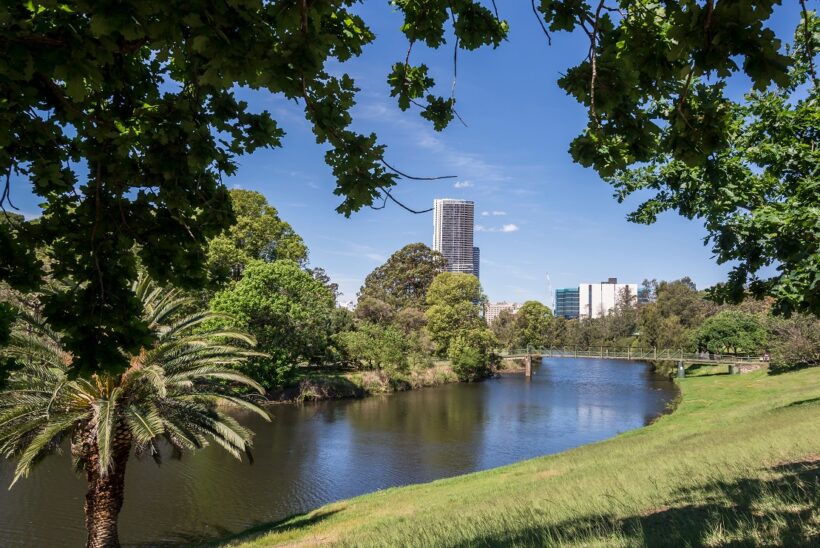Guido Carvajal, an expert in urban water resource management and academic at the Andrés Bello University, stresses the importance of investing, studying and managing water supply, considering international examples to start becoming more water-sensitive and, therefore, more sustainable regions or cities.
The latest rainfall gave a respite to the megasequence the country has been facing for 13 years, one of the most severe so far. With the favourable rains come challenges and opportunities, which Guido Carvajal, an academic at UNAB’s Faculty of Engineering, analyses: “it is advisable to move towards water-sensitive cities and not depend solely on climatic conditions to cushion the drought affecting Chile”.
According to Carvajal, who has traveled and is familiar with these cities, such challenges and opportunities include improving urban water management in an integrated and sustainable way, diversifying and increasing the supply of water resources, for example, through water recycling, aquifer recharge and desalination, as well as incorporating ecological and resilience functions into our built environment and infrastructure.
“These actions must be taken to prevent flooding, erosion and destruction of urban infrastructure. However, today, the outlook is uncertain, the notable lack of public policies that incentivise initiatives in this area and give it the importance it deserves is plain to see. We also see the behaviour of the community, all of which shows that we are a long way from concrete solutions to manage droughts, which will become increasingly severe as they are in turn enhanced by climate change,” says the expert.
To evolve, it is important to have water management at the urban level that aspires to what is known internationally as a “water sensitive city”. Internationally, there are initiatives that consider these concepts such as “Australia’s Water Sensitive Cities”, “China’s Sponge Cities”, “Singapore’s ABC Waters”, “The United States Low Impact Development”, and “Vancouver’s Rain City Strategy” (Wong et al., 2020), which are globally recognised.
A water-sensitive city is characterised by being liveable, resilient, sustainable and economically productive. Furthermore, water resources are supported by three central pillars that are integrated into the urban environment, according to the urban water management expert:
1.- Cities as water supply catchments that allow access to a diversity of water sources, supplied by an integrated mix of centralised and decentralised infrastructure.
Cities that deliver ecosystem services through the provision of services to the built and natural environment.
Cities that comprise water-sensitive communities with socio-political capital for sustainability and water-sensitive decision-making and behaviour, as indicated by experts in their 2009 Wong & Brown articles on the topic.
Water sensitivity requires a profound change
The first pillar of a water-sensitive city relates to the diversification of water sources beyond classic rainwater and runoff supply, including both centralised and decentralised solutions. These alternative water sources include aquifer (groundwater) recharge schemes, urban stormwater management, rainwater storage from roofs of houses and buildings, recycled wastewater and desalinated water.
Such alternatives should be evaluated considering aspects such as: investment and operating costs, prices, climate, environmental objectives and impacts, and risks. “In addition, it is important to mention that such a change takes time, so it will not solve the immediate drought problems we are currently facing. This could clearly prevent it from being given the necessary importance compared to other projects such as desalination, which today in some parts is being carried out,” explains Carvajal.
The second pillar of moving towards water-sensitive cities considers ensuring that future urban landscapes incorporate green opportunities and technologies, or rather, green functions. “Here, resilience to the impacts of climate change is ensured. That is, coping with future uncertainties in urban water supply and climate extremes, and providing ecosystem services to protect and buffer downstream aquatic environments and other ecological habitats from these impacts,” says the UNAB academic.
Examples of these uses include protecting the environment from urban runoff water pollution and rehabilitating urban watercourses through technologies such as constructed wetlands and bioretention systems.
Subsequently, the third pillar argues that cities comprising water-sensitive communities must take into account the values and aspirations of the community, as it is imperative that they govern urban design decisions and urban water management; a city must always be designed with the water environment in mind.
A water-sensitive city is therefore underpinned by its inherent social and institutional capital, which is reflected in the following: (1) communities that lead ecologically sustainable lifestyles and recognise the constant balance and pressure between consumption and conservation of cities’ natural capital; (2) industrial and professional capacity to innovate and adapt as reflective practitioners in city building; and (3) government policies that facilitate the adaptive evolution of a water-sensitive city.
In this context, the Australian Water Sensitive Cities project (watersensitivecities.org.au) has developed studies, tools and guidelines to measure, through indicators, the level of progress or development of a city in relation to the characteristics of a water-sensitive city. One of these is the benchmarking tool to map the current performance of a city’s urban water management against 34 indicators that characterise a water-sensitive city.
The 34 indicators relate to seven objectives of a water-sensitive city including promoting adaptive infrastructure, ensuring good water-sensitive governance, increasing community capital, achieving equity of essential services, improving productivity and resource efficiency, improving ecological health, and ensuring the quality of urban space.
Finally, and considering these elements, the expert and academic state that “Chile has the material and economic resources and human capital to move towards the development of water-sensitive cities. It is necessary to educate ourselves with already developed tools and to consider international practices”.
And he adds that “only in this way will we manage to improve sustainability in relation to urban water management in the short and medium term to make proper use of available water resources without depending on the climatic factor for the supply of the vital element,” Carvajal concludes.












